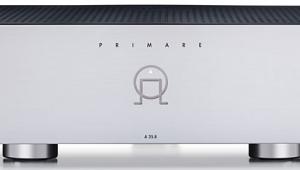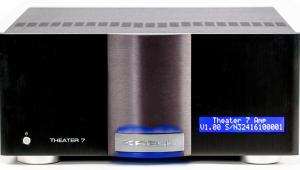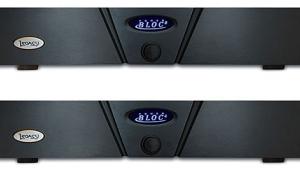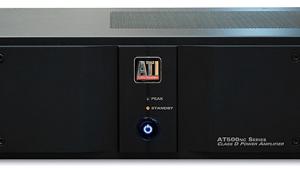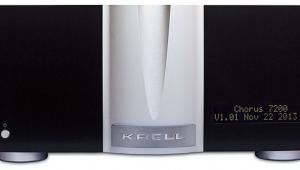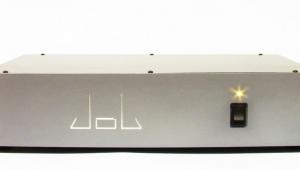Outlaw Model 7125 Amplifier Page 2
The AMP5 has long been my reference. Like all amps, it likes some speakers better than others. But it's a generally neutral-sounding amp, which profited by originating from the Mark Levinson stable (and from that inherited much of the same design philosophy). The Proceed line is now gone, but that's more a reflection on the state of the market than the inherent quality of the products.
The Model 750 amp put Outlaw Audio on the map. It was conservatively specified; our measurements in the September 1999 Stereophile Guide to Home Theater review put its clipping level (1% THD+noise) above 165Wpc into 8 ohms, all channels driven. Its sound was clean, punchy, and detailed.

It's six years later, and the 7125 is $100 cheaper than the 750 was when new. And the new amp, in most respects, sounds at least as good or better. That's the kind of progress we don't see enough of these days. On bright sounding program material with a lot of high frequency information and close-miked vocals (Holly Cole again leaps immediately to mind) the new amp definitely wins. In comparison, the 750 sounds a little dryer and more sibilant. The 7125 is richer sounding and smoother on top, but in no way soft or less well defined.
On more smoothly balanced recordings the race was closer, but the 7125 still nosed ahead with its more fluid sound. Voices and solo instruments, in particular, had more immediacy and were more fleshed-out. The difference was not dramatic, and neither amp sounds at all tube-like (and that's not a criticism!). But the improvements were sufficient to push the new amp solidly into the winner's circle.
Still, the somewhat more powerful 750 does have tighter, punchier bass. The 7125 never felt lacking in either extension or power at any level I could stand in my 3000 cubic foot room on the relatively low-sensitivity Energys. But one could argue that its bass was just a little soft. Still, that's a characteristic that will differ radically from room to room and speaker to speaker, and will be a non-issue in any event when the system includes one or more subwoofers. In that case, the 7125 will most likely be relieved of responsibility below 80Hz or so.
Compared to the Proceed AMP5, which sold for $5000 when first marketed in 1998, the Outlaw is definitely cooler and leaner-sounding. The Proceed in itself falls on the cool and precise (rather than warm and snuggly) side of the amplifier divide, but nevertheless it produced a more full-bodied sound than the Outlaw, with the bonus of somewhat cleaner, sweeter highs. The Proceed has just enough added bloom in the midrange to make instruments and voices sound subtly more alive than the Model 7125. That evergreen cliché of audio reviewers—palpable presence—is more evident in the sound of the AMP5 than in the Model 7125.
None of this takes away from the excellent sound of the new Outlaw amp. We're talking about $142 per channel here, versus $1000/channel in the Proceed (and probably significantly more for an equivalent amp today, nearly eight years after the Proceed was first introduced). The difference in sound is nowhere near as great as the gap in the per-channel cost.
That doesn't make a more expensive amplifier irrelevant; audiophiles pay big bucks every day for the sorts of advantages they sometimes provide. For those who can afford the best in every part of their home theater systems, that's fine. But for someone who has to apportion his or her resources carefully, the Outlaw puts the advantages of separates within the reach of a wide range of home theater fans. Or, if enough funds are available for either a megabuck power amp or some other area of the system that needs upgrading (but not both), the Model 7125 frees up funds that might be more productively spent on a new set of speakers or an upgraded video display.
Movie Time
You thought we'd never get here, right? But in many ways driving just two channels of a multichannel amp full range is more challenging than using five or seven channels with the bass apportioned to a subwoofer.
But this is ultimately a surround sound product, so I did, finally, set up the Model 7125 in my five-channel home theater system (two amp channels remained silent). The speakers were still primarily Energys, but this time an eclectic system based on the new Reference Connoisseur RC-70 (review in progress). The subwoofer was a HSU VTF-3, and the center channel a single Revel M22 (the Energy Reference Connoisseur RC-LCR center channel speaker and a new Energy subwoofer were not yet fully broken-in).
The Outlaw was just as satisfying on soundtracks as it had been on music—perhaps even more so. I began with an old favorite, Amistad. This is a superb soundtrack, but not in the usual, gunpowder and explosions sense (though there is a little of that near the end). In its mixing of subtle effects—clinking chains, the subdued ambience of indoor spaces—with a superb recording of John Williams' moving, choral-heavy score, this soundtrack develops a power far greater than all but a few in which the main object is to blow things up. I hadn't revisited this film in a while, and I found it hard to let go and move on to other material. The 7125 certainly earned more than its share of the credit in drawing me in.
I've raved before about the DVDs of the TV series Farscape, which I highly recommend if you have any interest in one of the best science fiction shows ever produced (even if you don't think you do, you just might find yourself a committed fan after seeing a few episodes). The series' quirky, dawn of the dead-like episode, "Eat Me," with its surprisingly subtle soundtrack, mixes eerie effects with spacious music cues in a mix that's as quietly absorbing as anything on the screen. The Outlaw gets the big picture and the small details, all 5.1-channels are drenched in depth, ambience and spaciousness, without ever sounding compressed or overblown. (The post-production, looped dialog is less natural sounding, but that's hardly the fault of the amp.)
The Island is a film derailed because it's really three disparate movies. Act one is a fascinating if underdeveloped tale of about what it means to be human when you're treated as something less. Act two is a clumsy action spectacle that belongs in a different film. But in its final act the movie combines some of the more appropriate action with a music video-like conclusion that includes a beautifully recorded choral track. Not a bad recovery for a movie that bombed at the box office. The combination of pounding action that segues into a soaring wrap-up is, sonically, both exhausting and uplifting. The Outlaw does its part in the big, blow-em-up bits and, more important, does nothing to diminish the spatially striking, almost ethereal choral finale.
Conclusion
In many respects, power amps are—or should be—the most invisible of audio components. They take what they receive, amplify it to a level and impedance suitable for driving loudspeakers, and that's it. In practice, however, what they do is possibly the most complicated operation in an audio system. They actually have to clone the signal they receive into a huge replica of itself, without changing anything but the scale. You can pay big bucks for a product that does that, and for some buyers, and some of those products, the expense will pay off.
But the Outlaw 7125 proves that you don't have to take out a second mortgage for an amplifier that provides compelling performance and qualifies as one of the bargains of the year. Highly recommended.
Highs and Lows
Highs
Clean highs, extended lows, convincing depth and soundstaging
Bargain price for seven channels of clean performance
Lows
Slightly cool and lean-sounding; not the best choice for speakers with the same qualities

